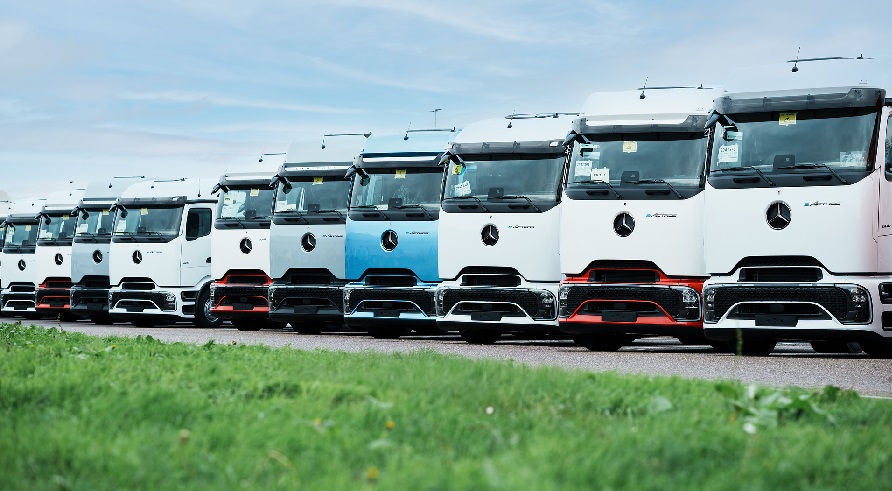In December 2023, the KsNi grant programme, aimed at the electrification of heavy transport in Germany, came to an end.
This created uncertainty, especially in the first half of 2024, when numerous electrification projects were postponed.
“Many clients indicated that they had to delay their electrification plans or simply abandon them because, without subsidies, they cannot afford the trucks,'” points out Bruno Lukas, founder of Green Logistics Enabler (GLE).
However, the market found alternatives.
The key, Lukas tells Mobility Portal Europe, was a change in perspective: “The focus began to shift more towards total cost of ownership (TCO) calculations and not just the initial price of the vehicles.”

“Comparing the price of a diesel truck directly with that of an electric one is a big mistake; it’s like comparing apples with oranges,” he adds.
This concept reshaped the German market’s view towards operational cost (OPEX) analysis, prioritising the comprehensive ecosystem surrounding eTrucks.
According to the expert, the integration of charging infrastructure, the source of electricity, and prices per kilowatt-hour are crucial to establishing a fair competitiveness with diesel trucks.
“If the fleet operator can charge the vehicles at a price between 20 and 30 euro cents per kWh, TCO parity can be reached,” he explains.
In the long term, electrification projects may prove to be more economical in terms of OPEX, and if these savings are optimised, they could be used to refinance the initial investment (CAPEX).
“This means the purchase of a more expensive truck can be justified,” Lukas notes.
And he emphasises: “That was the lesson the market learned last year: to consider the entire electrification ecosystem surrounding the truck.”
Thus, by adopting a long-term perspective, spanning six to eight years, it is possible to build a solid and successful business case.
In this context, GLE is collaborating with fleet operators in the analysis, planning, and implementation of electric truck fleets, as well as in organising tests of these vehicles.
Local intervention to boost eTruck adoption
Following the end of the national KsNi programme, some federal states, such as Baden-Württemberg and North Rhine-Westphalia, launched state-level subsidies to mitigate the impact.
Although limited in scope and duration, these initiatives set a precedent.
Their success was reflected in the rapid exhaustion of the funds and the implementation of projects.
“These two programmes were more of a political gesture towards the logistics industry,” Lukas observes.
As he explains, it was a way of showing understanding of the need for more support and funding, as well as demonstrating their willingness to back the transition process and ensure it could be carried out effectively.
It is worth mentioning that Amazon’s recent purchase of 200 electric trucks from Mercedes-Benz highlights that electrification projects and electric transport are currently expanding and developing.
“There is definitely a viable business model if the right conditions are in place,” affirms the founder of GLE.
And that’s not all.
Temporary CO2 toll exemptions introduced by the Ministry of Transport also aim to incentivise operators.
Currently, eVehicles are exempt from the tolls until the end of this year, while diesel vehicles are required to pay, thus increasing transport costs for combustion-engine vehicles.
From 2026 onwards, electric trucks will also have to pay the CO2 toll, but only 25% of the amount applied to diesel vehicles.
“This helps calculate the savings,” Lukas confirms.
And he explains: “For example, an electric truck with an annual mileage of 100,000 kilometres on highways can save up to 30,000 euros just in toll fees, which is an important incentive, although likely not sufficient.”
According to the latest data published by the European Automobile Manufacturers Association (ACEA), 3,413 100% electric trucks were registered in Germany in 2024.
This represents a 57.4% increase compared to the 2,169 registered during the same period in 2023.
Sector expectations for 2025
“The electric truck market will begin to scale, although still slowly this year,” he states.
To ensure the success of electrification, operators are hoping for a more predictable environment, especially in light of the upcoming elections at the end of February.
“What fleet owners need most from policies, especially from the new government, is planning security,” he emphasises.
Operators need to be able to make calculations over a five- or six-year period.
At the same time, the founder of GLE highlights the need to reduce energy costs and work with depot charging models, avoiding “refuelling” at public highway stations, where costs can be too high.
“If companies must rely on the power grid, energy prices must be below 30 euro cents per kilowatt-hour for it to be competitive against diesel. If they rise to 40, 50, or 60 cents, it becomes unviable,” he indicates.
A notable case is the combined solution of green energy supply and financing provided by their power and service provider, Electrofleet GmbH, which serves as an example of how fleet operators can implement depot charging without the need for their own CAPEX investments.
Additionally, reducing the prices of eTrucks, which are currently three times higher than those of diesel vehicles, is crucial.
“We need to work towards reducing that difference to two times, or even 1.5 times, to make them more accessible,” he explains.








